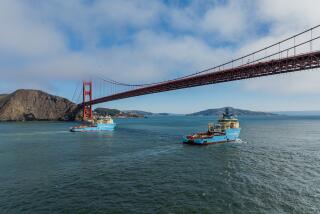A scary science mystery: What happened to the ocean’s plastic trash?
- Share via
Today’s science mystery comes courtesy of researchers from Australia, Spain and Saudi Arabia, who have been traveling the seven seas tracking ocean-borne human refuse, much of it plastic. According to their report in Proceedings of the National Academy of Sciences, some 99% of the expected debris is missing.
The researchers, who circumnavigated the globe in 2010 and ’11 trailing fine-mesh nets, expected to find millions of tons of floating plastic trapped in vast ocean gyres such as the Great Pacific Garbage Patch. But they could account for only about 40,000 tons.
That’s disturbing, because of the possibility that fish and other marine animals are eating it. If so, team member Carlos Duarte of the University of Western Australia told Science, “There is potential for this plastic to enter the global ocean food web ... and we are part of this food web.”
Duarte says wave action and the sun can break up floating plastic into ever smaller pieces, finally small enough to be mistaken for food.
The plastic, experts say, attracts and concentrates toxic pollutants such as DDT, PCBs and mercury, which can then be ingested by marine creatures, and subsequently by humans.
Experts speculated in the Science report that some of the missing plastic has washed ashore, degraded into microscopic pieces or fallen to the ocean floor. “Microbes may even be eating the stuff,” the report said.
But visible or invisible, the scale of human dumping into the ocean is worrisome. “I don’t think we can conceive of the worst-case scenario, quite frankly,” one researcher told Science. “We really don’t know what this plastic is doing.”
Keep up to date with The Economy Hub by following @hiltzikm.
More to Read
Inside the business of entertainment
The Wide Shot brings you news, analysis and insights on everything from streaming wars to production — and what it all means for the future.
You may occasionally receive promotional content from the Los Angeles Times.











